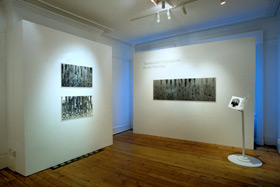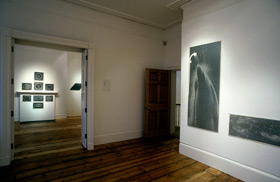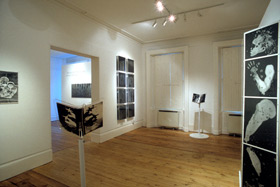

Translucent Exposures
Impressions Gallery, York
13 January – 3 March 2001



In Translucent Exposures, the artist and ex-scientist Annie Halliday returns to the technological origins of photography to re-examine the potential of the photogram. The technique, which involves neither camera nor lens, but only light, an object, and light sensitive materials, still retains some of the aura of mystery that surrounded early photographic images. Halliday deploys this wonder-inducing capability to enhance her exploration of that relationship between light and its absence, which informs our perception of the visual world. Through the sensitive selection of objects, such as ice, water, and various glass containers, Halliday has created images that have an intense, fragile and haunting beauty.
As the photogram image is a ‘negative’, light that refracts and reflects through Halliday’s chosen glass-ware registers on the light-sensitive surface as a capillary network of dark lines; as webs and fibrous husks of shadow light. In the triptych swimming III, darkness trapped between the sole of a foot and the water splashed surface on which it walks, shines out. A tall box-like installation, titled in the dark, has photograms of a female body mounted on its surfaces. Containing nothing, this box bears the life-size signs of a body that has pressed against it and moved on. Halliday’s work for Translucent Exposures demonstrates a preoccupation with ephemeral traces left in the wake of the process of living.
Looking at a photogram, there can be no question of mistaking the image for an illusion of reality. The objects’s identity has to be decoded from the anatomy of dark marks cast on light sensitive material by the light held within its structure. This necessary translation, in conjunction with Halliday’s preoccupation with traces, foregrounds the image, not as captured presence, but as a sign of that presences’s absence.
John Clarke, Impressions Gallery
‘...her work succeeds because it seems to have derived from ancient and mysterious sources...Halliday is adept at drawing streaky, ectoplasmic swirls from careful arrangements of glass objects, like Morandi still lifes in soluble form...In the Dark is a haunting anti-impression of a human being...much as Rachel Whiteread reveals the poetry of anti-matter, Halliday captures the poignancy of our own negative space.’
- Alfred Hickling, The Guardian
‘...photo-works that appear to seduce the image rather than snap or trap it.’
- Robert Clark, The Guide
Continue to translucent exposures gallery...
